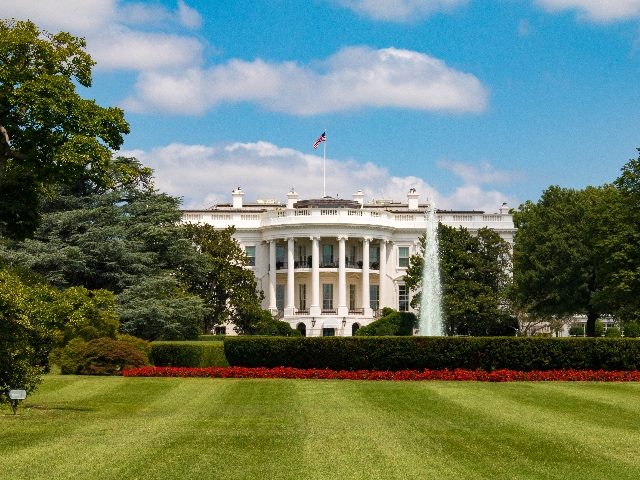The Gist
- Targeted messaging matters. Trump and Harris campaigns showed the power of connecting with core voter demographics through focused, resonant messaging.
- Agility is key. The ability to pivot quickly and effectively can make or break a campaign.
- Avoid tone-deaf messaging. Overly aggressive or off-key attacks can backfire, alienating undecided voters and weakening broader appeal.
American voters head to the polls Nov. 5 to decide the next US President for Campaign '24. Former President Donald Trump (Republican) and Vice President Kamala Harris (Democrat) headline the ticket.
Marketing plays a pivotal role in shaping public perception and swaying undecided voters in the battle for the nation's highest office. Their campaign strategies — especially in videos and messaging — have seen notable triumphs and glaring missteps.
This article examines the best and worst from each side, analyzing how their marketing efforts resonate with or alienate different segments of the electorate, providing an objective look at the effectiveness of their campaign communications in this volatile race.
And marketers can pick up a few lessons along the way.
Overview of Campaign '24
Dramatic shifts and unforeseen events have marked the 2024 presidential race. Initially, it featured a contest between former President Trump and President Joe Biden. However, after an attempted assassination of former president Trump and Biden’s declining performance, party pressure to decline and subsequent withdrawal, Vice President Harris stepped in as the Democratic nominee. Harris' entry revitalized her party's campaign, while Trump’s selection of JD Vance as his running mate added new dynamics.
Both campaigns are now navigating a complex and rapidly evolving political environment.
Vice President Harris' campaign swiftly adapted, highlighting her strengths and emphasizing her vision for the future, which resonated with voters in a way that Biden's messages had struggled to do. The transition was marked by a shift in marketing strategy, with a renewed emphasis on Harris’ unique qualifications and her ability to bring fresh leadership to the White House.
Trump's campaign, on the other hand, continued to hammer home its core themes of economic recovery and border security. However, Trump's choice of JD Vance as his running mate introduced a new element into the race. While Vance's selection aimed to solidify support among Trump’s base and appeal to working-class voters, it also sparked debate and raised questions about his broader appeal, particularly among more moderate Republicans and independent voters.
Harris’ decision to select Minnesota Governor Tim Walz as her running mate also played a pivotal role in reshaping the campaign narrative. Walz’s background and appeal to Midwestern voters helped to strengthen Harris' position in critical swing states, providing a much-needed boost where Biden had struggled. His presence on the ticket not only stabilized the campaign but also positioned Harris as a strong contender capable of reaching across traditional partisan lines.
As the race intensifies, both campaigns are navigating these complexities while continually adapting their marketing strategies to an ever-evolving political environment.

Trump Campaign’s Marketing Successes
One of the key strengths of the Trump campaign in 2024 has been its ability to maintain a strong connection with its base while also attempting to reach beyond it. A notable example is a series of videos that highlight the economic recovery under his previous administration, juxtaposed against the challenges faced during the Biden presidency. These videos, often featuring testimonials from everyday Americans, effectively tap into the nostalgia of his supporters and reinforce the narrative that Trump's leadership is crucial for returning to prosperity.
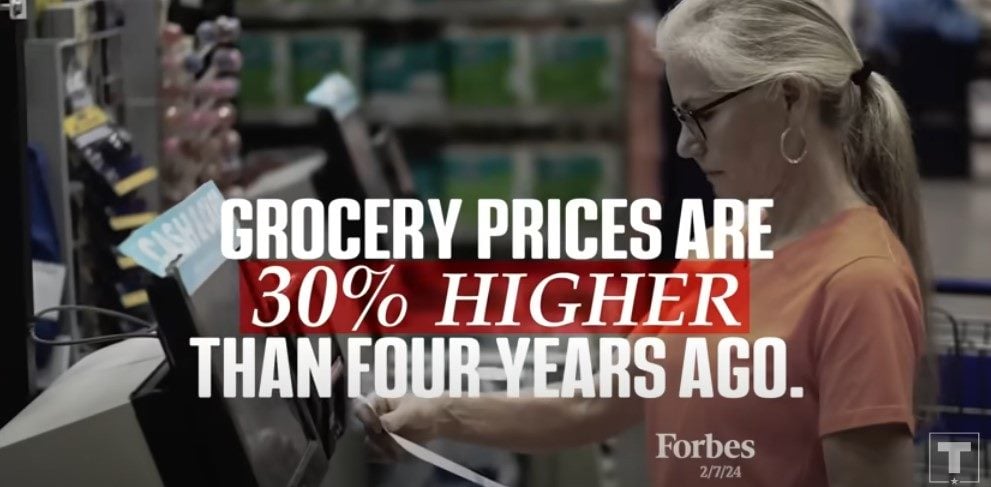
The video prompts viewers to “Ask yourself — are you better off than you were 4 years ago? Is it easier for you to go and buy things in the stores than it was 4 years ago?”
After a year-long absence from X, formerly known as Twitter, Trump returned with a Hollywood-style campaign video that portrays him as the nation’s hero.
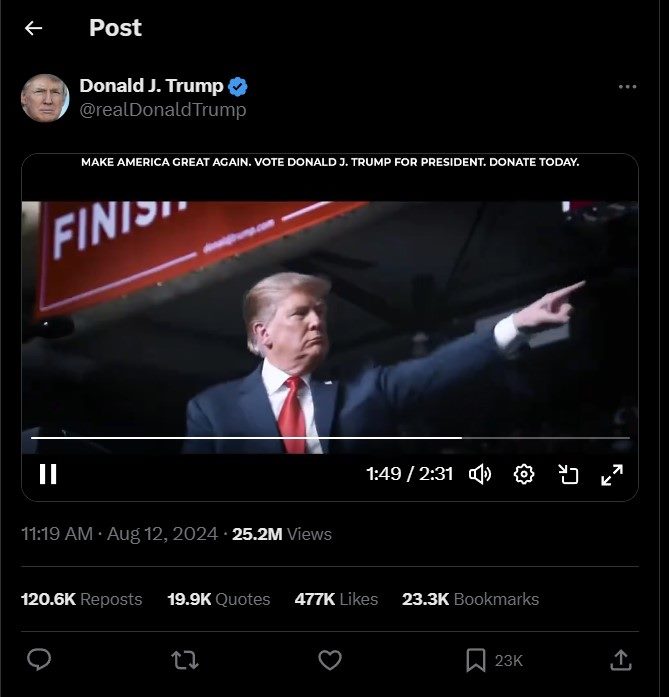
The video features footage of the FBI raid on his Florida estate to recover classified documents, accompanied by Trump's vow to fight back and “obliterate the deep state.”
Ryan Waite, VP of public affairs at Think Big, a public affairs digital advocacy firm, told CMSWire that Trump’s ads are heavily geared toward his loyal base — conservative voters who resonate with his "America First" messaging.
“His strategy focuses on older, rural, and working-class demographics, emphasizing themes like economic resurgence, national security, and a return to traditional values,” said Waite.
One recent ad from the Trump campaign refers to Vice President Harris as “America’s border czar,” stating that “[Harris] is America's border czar and she's failed us — under Harris over 10 million illegally here. 250,000 Americans dead from fentanyl on Harris’ watch.”
The video goes on to say that “Kamala Harris is Failed. Weak. DANGEROUSLY Liberal,” a message that is likely to appeal to President Trump’s core constituents.
A second new Trump ad reinforces the message by using similar footage from the NBC News interview, but adds a clip of Harris laughing.
This ad, part of a $12.2 million campaign, is being targeted at key swing states, including Pennsylvania, Georgia, Arizona, Wisconsin, Michigan and Nevada.
The Trump campaign has targeted the use of these ads on platforms frequented by conservative audiences. Focusing on issues such as immigration and law enforcement, they have successfully galvanized his base by echoing their concerns and fears, while also reaching new, younger voters who align with these views. The strategic deployment of these messages on social media has amplified their reach, leading to widespread engagement and discussion.
The attempted assassination of President Trump was a brutal assault on democracy, an ordeal no candidate should ever face. Amid the chaos, Trump displayed remarkable courage and resolve, raising his fist in a power salute — a gesture meant to convey strength and reassure the crowd. This moment, poignantly captured by Associated Press photographer Evan Vucci, symbolized his resilience and determination in the face of danger.
In it, President Trump stands, his fist raised in the air, his ear bloodied by the bullet that barely missed his head, an American flag billowing behind him, FBI agents surrounding him. An entire convention of marketing professionals could not have designed an image more empowering and presidential — the perfect marketing campaign image.
“Trump's creative strategy leverages high-energy, emotionally charged videos that emphasize his achievements and portray him as a strong, decisive leader,” explained Waite. “His ads often use stark contrasts, pitting his vision of a ‘great America’ against the perceived failings of the current administration.”
Waite said that although effective for his base, one of his most recent ads puzzlingly focuses on Joe Biden, rather than Kamala Harris, something Waite attributes to the ad already being already cut prior to President Biden dropping out.
“The tone is often confrontational and nostalgic, invoking the success of his first term while warning of the dangers of the current administration. The visual style consists of bold, dramatic visuals with patriotic imagery (rallies, flags, military, etc.) and high-contrast editing designed to evoke strong emotional responses,” said Waite.
The media's reaction to these efforts has been mixed, with some outlets critiquing the simplicity of the messaging, while others acknowledging the campaign's effectiveness in mobilizing its core supporters. Public reception, particularly among Trump's loyal base, has been overwhelmingly positive, with these marketing efforts reinforcing the loyalty of his existing supporters and energizing them for the election.
Related Article: Marketing in the Polarized World of 2024
Harris Campaign’s Marketing Successes
The Harris campaign has seen success in its ability to pivot and respond to emerging issues with agility. A standout example is the series of ads addressing healthcare and climate change — issues that resonate deeply with their target demographics, particularly younger voters and those in suburban areas. These ads, often featuring Harris in direct and personable settings, have been successful in humanizing the campaign and making it relatable to a wide audience.
“Harris targets younger, more diverse, and urban voters, particularly those who prioritize social justice, reproductive rights and climate change,” said Waite. “Her campaign also aims to appeal to suburban women and minority communities.”
Initially, President Biden was the leading candidate on the Democratic ticket, so we're going to examine his role, as well. His campaign swiftly took to the airwaves after announcing his re-election bid in April 2023, launching a 90-second ad in collaboration with the Democratic National Committee. The spot, aimed at safeguarding Americans' freedoms, signals the campaign's commitment to this central theme.
“Courage, opportunity, democracy, freedom: they’re the values and beliefs that built this country and still beat in our hearts. But they’re under attack by an extreme movement that seeks to overturn elections, ban books and eliminate a woman’s right to choose,” the narrator says in the ad.
The Biden campaign's swift release of the ad following his re-election announcement effectively leveraged the theme of protecting American freedoms, tapping into a universally resonant value. By collaborating with the Democratic National Committee, the ad not only reinforced a unified Democratic front but also aimed to expand its appeal to a broader audience. With its timely, emotionally charged messaging, the ad positioned Biden as a steadfast defender of core American values, capitalizing on the momentum of his campaign launch while rallying and mobilizing voters.
Following the State of the Union address in March 2024, the Biden campaign debuted an ad that cleverly highlighted the administration’s accomplishments while the president playfully addressed his age at both the start and end of the spot.
"Look, I’m not a young guy. That’s no secret,” Biden, 81, says in the ad. “But here’s the deal. I understand how to get things done for the American people. I led the country through the Covid crisis. Today, we have the strongest economy in the world."
The campaign has also been effective in using inclusive messaging, highlighting the diversity of their coalition and promoting themes of unity and progress. This approach has helped the campaign counter opposition narratives that paint the Democratic Party as divided. One of the most successful aspects has been their ability to harness the power of grassroots organizing through digital platforms, allowing them to connect with voters in a more personal and direct manner.
On July 25th, Vice President Harris launched her first official campaign ad, a one-minute spot titled, "We Choose Freedom." Set to Beyoncé’s 2016 hit "Freedom," the ad showcases Harris’ vision of a just and free America, beginning with powerful visuals of everyday Americans — kitchen workers, a woman in a hard hat and a young family biking together.
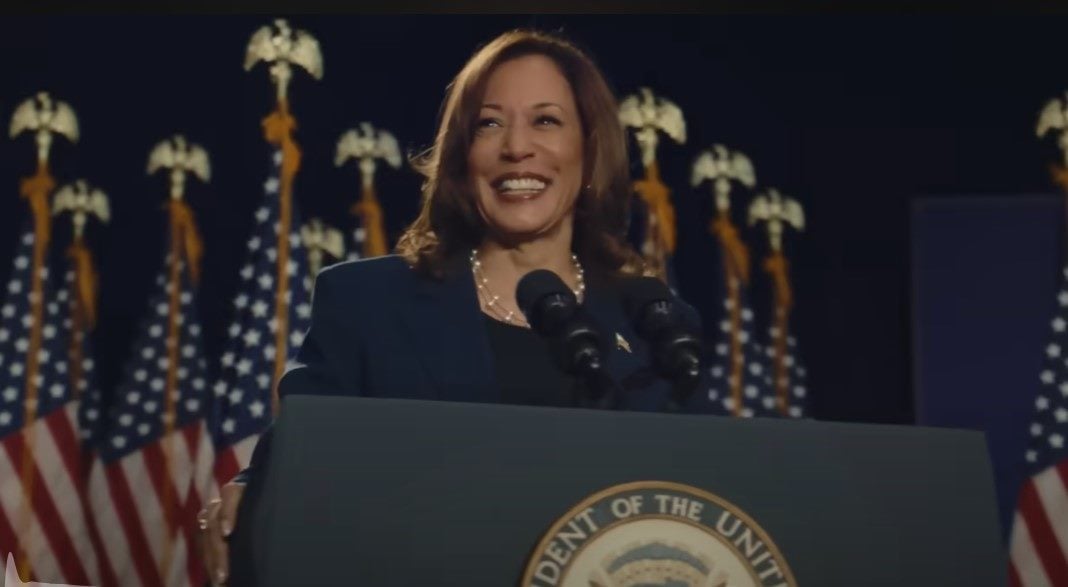
In the video, Harris’ voiceover paints a picture of her aspirations for the nation: “The freedom not just to get by, but to get ahead. The freedom to be safe from gun violence. The freedom to make decisions about your own body. Where no one is above the law. We believe in the promise of America, and we’re ready to fight for it. Because when we fight, we win.”
The ad effectively uses emotional messaging, cultural relevance through Beyoncé's "Freedom," and inclusive imagery to present Harris as a unifying candidate committed to a hopeful, just America. With a clear call to action and a positive vision for the future, the ad is designed to resonate deeply with a broad audience and mobilize voter support.
A 60-second ad from Harris, titled "Fearless," emphasizes her career journey, highlighting her efforts as a prosecutor to hold banks, drug companies and criminals accountable. The ad is part of a $50 million national campaign that ran through the Democratic National Convention in August.
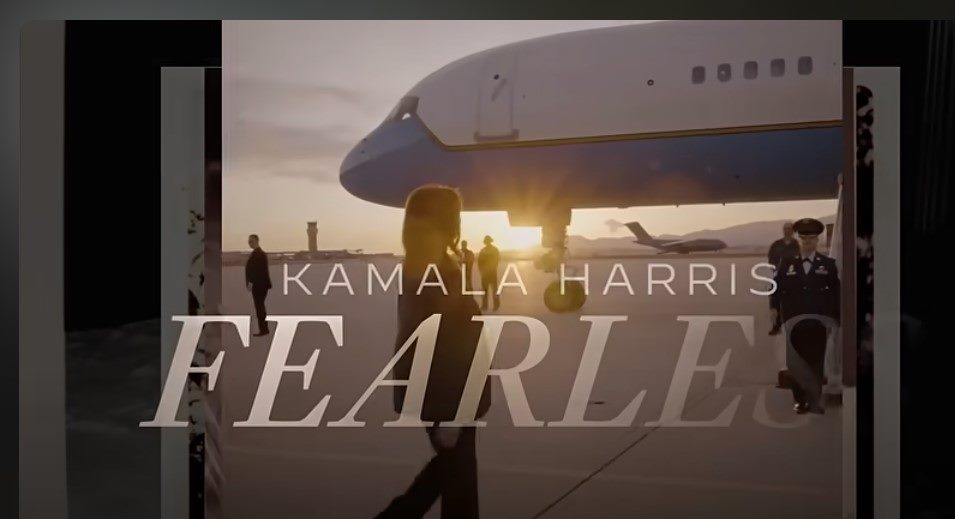
In the video, Harris says, "We believe in a future where every person has the opportunity not just to get by but to get ahead." It concludes with a warning about Trump's intent to "take our country backward" by giving tax breaks to billionaires and repealing the Affordable Care Act, according to Harris' campaign.
Waite said that Harris’ ads focus on issues such as reproductive rights and economic justice, highlighting her role in championing key Democratic values. “Her messaging is often forward-looking, centered on unity and addressing systemic issues like healthcare and social justice. Similar to Trump's strategy, great for the base; however, the campaign needs to more effectively communicate a message of economic growth to connect with a broader range of voters, especially in battleground states.”
Waite explained that the tone is compassionate and hopeful, aiming to build a narrative of steady leadership and moral integrity, and is less confrontational, instead focusing on uplifting and empowering themes.
“The visual style is professional, polished visuals that emphasize diversity and community,” said Waite. “The ads use softer tones, diverse imagery, and a mix of personal storytelling and policy focus to connect with viewers on an emotional and intellectual level.”
Media reactions to the Biden/Harris campaign's marketing efforts have generally been favorable, with many commentators noting the campaign's skillful adaptation to the rapidly changing political landscape. Public reception has also been strong, particularly among key demographic groups that are crucial to the Democratic coalition. These marketing successes have helped stabilize the campaign during turbulent moments and have kept their message consistent and resonant across various voter segments.
Related Article: Should Brands Wade Into the Political Fray?
Marketing Failures for Trump Campaign
While the Trump campaign has had its share of successes, there have also been notable missteps that have hindered its efforts to expand its appeal beyond its core base. One significant example was the campaign's persistent focus on questioning Joe Biden's age and mental fitness.
While these attacks energized Trump's loyal supporters, they often appeared excessive to undecided voters and older demographics, who may have found the messaging off-putting or disrespectful. This focus not only failed to sway these voters but also risked alienating a crucial demographic that the campaign needed to win over.
Another marketing failure involved the rollout of ads and Tweets that attempted to paint American cities as dangerous and chaotic under Democratic leadership, alluding to speculation that such cities would be even worse under the leadership of Harris. While intended to stoke fears and bolster Trump's "law and order" stance, these ads were perceived by some as racially charged and out of touch with the experiences of voters in those areas. The negative backlash, particularly in swing states with diverse populations, suggested that the campaign misjudged the broader public's sentiment, leading to a strategy that may have done more harm than good.
These missteps highlight a recurring challenge for the Trump campaign: the difficulty of balancing aggressive messaging with the need to broaden appeal. While the base was energized, the failure to connect with more moderate or undecided voters ultimately limited the effectiveness of these efforts.
Marketing Failures for Harris Campaign
The Biden and Harris campaigns, despite their successes, has also faced significant challenges in its messaging. One of the key failures occurred when Biden, before stepping down, attempted to counter Trump's attacks by emphasizing his experience and long tenure in government. Instead of reassuring voters, this message sometimes reinforced concerns about his age and ability to bring fresh ideas to the table, particularly among younger voters looking for change. This misalignment with voter sentiment contributed to Biden's decline in the polls and his eventual withdrawal from the race.
After Harris took over, the campaign faced additional challenges in navigating the transition. While Harris brought renewed energy to the campaign, some early attempts by Harris (and later, Walz) to criticize Trump's communication style — such as labeling his speeches as "weird" or erratic — didn't always resonate as intended. These critiques, while accurate for some, were perceived by others as overly personal or lacking substance, detracting from the more policy-focused messaging that many voters wanted to hear. This approach risked alienating voters who were more concerned with issues than character, leading to a period of uncertainty before the campaign found its footing.
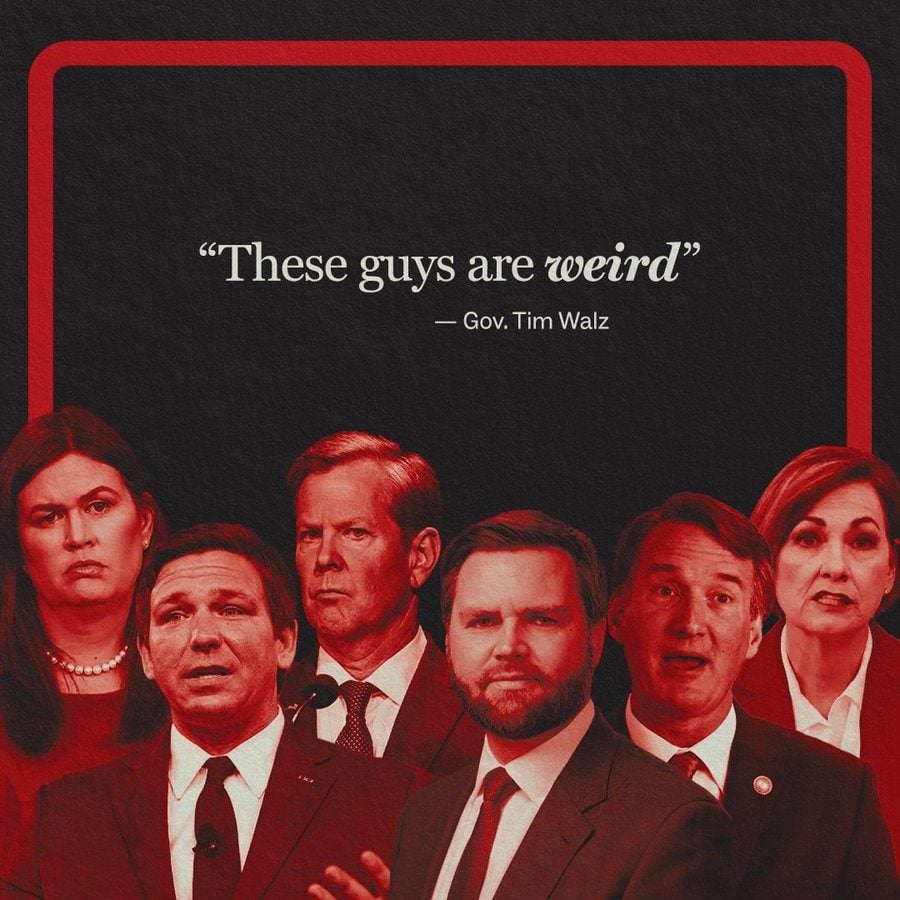
More recently, the Harris campaign came under scrutiny for running a misleading ad on Google, which, according to Axios, was designed to appear like a legitimate news article. The ad, when clicked, led users to a webpage that was crafted to look like an independent news source but was, in fact, campaign propaganda. This tactic raised concerns about the ethical implications of using deceptive practices to influence voters, as it blurred the line between genuine news reporting and political advertising.
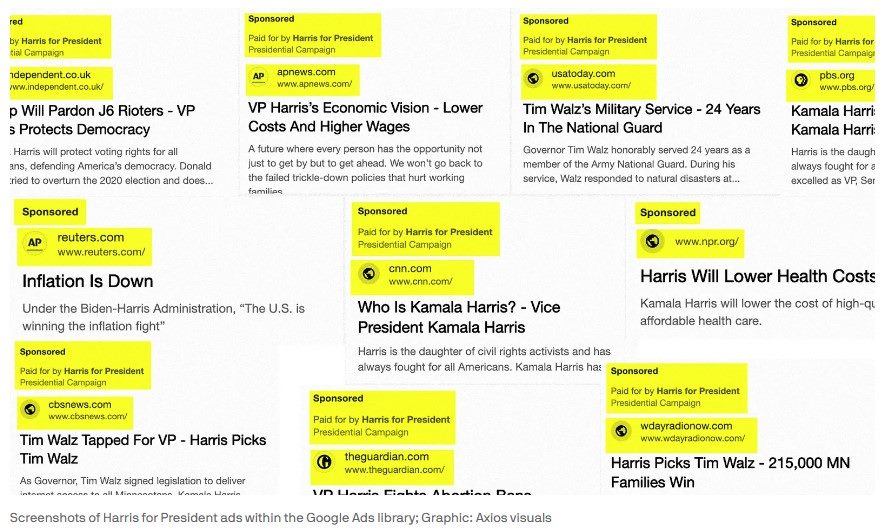
The backlash against this approach highlighted the risks involved in using misleading marketing tactics, especially in the politically charged environment of an election campaign. This example illustrates how such strategies, which according to Google do not violate its rules, can still damage a campaign's credibility and undermine trust in the democratic process.
Final Insights and Marketing Lessons Learned from the 2024 Presidential Race
The 2024 presidential race has provided a wealth of insights into the evolving dynamics of political marketing in a deeply polarized environment. As campaigns adapt to rapidly changing voter expectations and the unpredictable nature of modern media, several key takeaways have emerged that future candidates will undoubtedly consider.
Strategic Approaches of Trump and Harris
Waite suggested that Trump’s strategy relies on energizing his base with bold, emotionally charged content, while Harris aims to build a coalition through inclusive, forward-looking messaging.
"The problem with both campaigns is they are not attempting to expand their appeal beyond their core supporters,” said Waite. “It's safe to assume that both bases will be firmly planted in their opposite corners, so the real target should be the persuadable middle."
The Power of Targeted Messaging
One of the most important lessons from this campaign is the power of targeted messaging that resonates with core voter demographics. Both campaigns have had moments where they effectively connected with their bases by addressing the issues that mattered most to them. For Trump, focusing on economic recovery and national security reinforced his appeal to his loyal supporters, while the Biden/Harris campaigns' emphasis on healthcare, climate change and inclusivity successfully mobilized key demographics such as younger voters and minorities.
Waite said to capture that audience, which will decide this election, Trump needs to attempt to soften his divisive image, and Harris should show a stronger focus on economic issues.
“As we move closer to the election, the respective campaigns may move more in that messaging direction, but for now it seems the myopic strategy is "'fire up the base.'"
The Importance of Agility
Another crucial lesson is the importance of agility and the ability to pivot when necessary. The Harris campaign demonstrated this when Harris took over and revitalized the ailing Biden campaign, shifting its focus to her strengths and more dynamic messaging. This flexibility allowed the campaign to regain momentum after a period of uncertainty, showing that the ability to adapt to changing circumstances is vital in maintaining voter engagement.
Risks of Tone-Deaf Messaging
However, both campaigns also highlighted the risks of overly aggressive or tone-deaf messaging. Trump's relentless focus on Biden's age and mental fitness, while energizing his base, alienated some undecided voters and older Americans who found these attacks excessive. Similarly, Harris's early attempts to critique Trump's communication style by focusing on his character flaws sometimes fell flat, as voters sought more substantive discussions on policy rather than personal attacks.
These missteps underscore the need for campaigns to carefully balance their messaging — energizing the base while also reaching out to undecided voters and those who policy-focused discussions might sway. Overly negative or personal attacks can backfire, especially in a polarized environment where voters are already entrenched in their views.
Digital Platforms and Personalized Campaigns: Cutting Through TikTok Clutter
The 2024 race also reflects broader changes in political marketing, particularly the increasing importance of digital platforms and the need for campaigns to be more personalized and responsive. As voters become more discerning and less tolerant of generic messaging, the campaigns that succeed will be those that can tailor their outreach to specific demographics, using data-driven insights to connect with voters on issues that matter most to them.
“Another issue is that in an environment where the campaigns are not competing for the attention of the voter with the opposition but rather they are competing with everything from TikTok dances to viral sports clips, neither campaign has done anything noteworthy to cut through the clutter,” Waite explained.
Conclusion: Lessons from Campaign '24
Campaign '24 has been a masterclass in modern political marketing, highlighting both its power and pitfalls. The race between Trump and Harris underscores the critical need for agile, targeted messaging that resonates with core demographics while also attracting undecided voters.
Both campaigns have experienced triumphs and missteps, reflecting the delicate balance required in a polarized electorate. The lessons from this campaign — authenticity, digital strategy and substantive policy discussions — will shape future political communication, with the most adaptive campaign likely determining the election's outcome.
Are you feeling the lessons, marketers?
